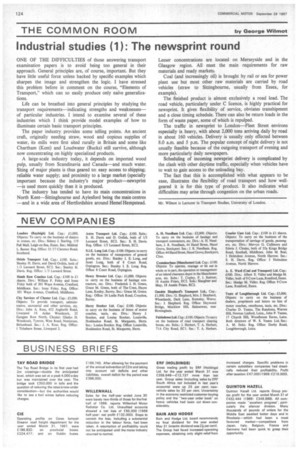THE COMMON ROOM
Page 126

If you've noticed an error in this article please click here to report it so we can fix it.
by George Wilmot
Industrial studies (1): The newsprint round
ONE OF THE DIFFICULTIES of those answering transport examination papers is to avoid being too general in their approach. General principles are, of course, important. But they have little useful force unless backed by specific examples which sharpen the image and strengthen the logic. I have stressed this problem before in comment on the course, "Elements of Transport," which can so easily produce only naive generalizations.
Life can be breathed into general principles by studying the transport requirements—indicating strengths and weaknesses— of particular industries. I intend to examine several of these industries which I think provide model examples of how to illuminate certain basic transport principles.
• The paper industry provides some telling points. An ancient craft, originally needing straw, wood and copious supplies of water, its mills were first sited rurally in Britain and some like Chartham (Kent) and Loudwater (Bucks) still survive, although now concentrating on highly specialized products.
A large-scale industry today, it depends on imported wood pulp, usually from Scandinavia and Canada—and much water. Siting of major plants is thus geared to: easy access to shipping; reliable water supply; and proximity to a large market (specially important because the industry's major product—newsprint —is used more quickly than it is produced.
The industry has tended to have its main concentrations in North Kent—Sittingbourne and Aylesford being the main centres —and in a wide area of Hertfordshire around Hemel Hempstead. Lesser concentrations are located on Merseyside and in the Glasgow region. All meet the main requirements for raw materials and ready markets.
Coal (and increasingly oil) is brought by rail or sea for power plant use but most other raw materials are carried by road vehicles (straw to Sittingbourne, usually from Essex, for example).
The finished product is almost exclusively a road load. The road vehicle, particularly under C licence, is highly practical for newsprint. It gives flexibility of service, obviates transhipment and a close timing schedule. There can also be return loads in the form of waste paper, some of which is repulped.
The traffic' in newsprint to London—Fleet Street environs especially is heavy, with about 2,000 tons arriving daily by road in about 160 vehicles. Delivery is usually only effected between 8.0 a.m. and 5 p.m. The popular concept of night delivery is not usually feasible because of the outgoing transport of evening and more particularly daily newspapers.
Scheduling of incoming newsprint delivery is complicated by the clash with other daytime traffic, especially when vehicles have to wait to gain access to the unloading bay.
The fact that this is accomplished with what appears to be ease, illustrates the flexibility of road transport and how wellgeared it is for this type of product. It also indicates what difficulties may arise through congestion on the urban roads.




































































































































































